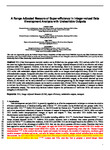A Range Adjusted Measure of Super-efficiency in Integer-valued Data Envelopment Analysis with Undesirable Outputs
| dc.contributor.author | Chen, C | |
| dc.contributor.author | Liu, H | |
| dc.contributor.author | Tang, Lijun | |
| dc.contributor.author | Ren, J | |
| dc.date.accessioned | 2020-11-16T09:11:50Z | |
| dc.date.issued | 2021-09-24 | |
| dc.identifier.issn | 1478-9906 | |
| dc.identifier.issn | 2512-6660 | |
| dc.identifier.uri | http://hdl.handle.net/10026.1/16655 | |
| dc.description.abstract |
<jats:title>Abstract</jats:title> <jats:p>DEA (data envelopment analysis) models can be divided into two groups: Radial DEA and non-radial DEA, and the latter has higher discriminatory power than the former. The range adjusted measure (RAM) is an effective and widely used non-radial DEA approach. However, to the best of our knowledge, there is no literature on the integer-valued super-efficiency RAM-DEA model, especially when undesirable outputs are included. We first propose an integer-valued RAM-DEA model with undesirable outputs and then extend this model to an integer-valued super-efficiency RAM-DEA model with undesirable outputs. Compared with other DEA models, the two novel models have many advantages: 1) They are non-oriented and non-radial DEA models, which enable decision makers to simultaneously and non-proportionally improve inputs and outputs; 2) They can handle integer-valued variables and undesirable outputs, so the results obtained are more reliable; 3) The results can be easily obtained as it is based on linear programming; 4) The integer-valued super-efficiency RAM-DEA model with undesirable outputs can be used to accurately rank efficient DMUs. The proposed models are applied to evaluate the efficiency of China’s regional transportation systems (RTSs) considering the number of transport accidents (an undesirable output). The results help decision makers improve the performance of inefficient RTSs and analyze the strengths of efficient RTSs.</jats:p> | |
| dc.format.extent | 378-398 | |
| dc.language | en | |
| dc.language.iso | en | |
| dc.publisher | Research Information | |
| dc.title | A Range Adjusted Measure of Super-efficiency in Integer-valued Data Envelopment Analysis with Undesirable Outputs | |
| dc.type | journal-article | |
| dc.type | Journal Article | |
| plymouth.issue | 4 | |
| plymouth.volume | 9 | |
| plymouth.publication-status | Published | |
| plymouth.journal | Journal of Systems Science and Information | |
| dc.identifier.doi | 10.21078/JSSI-2021-378-21 | |
| plymouth.organisational-group | /Plymouth | |
| plymouth.organisational-group | /Plymouth/Faculty of Arts, Humanities and Business | |
| plymouth.organisational-group | /Plymouth/Faculty of Arts, Humanities and Business/Plymouth Business School | |
| plymouth.organisational-group | /Plymouth/REF 2021 Researchers by UoA | |
| plymouth.organisational-group | /Plymouth/REF 2021 Researchers by UoA/UoA17 Business and Management Studies | |
| plymouth.organisational-group | /Plymouth/Users by role | |
| plymouth.organisational-group | /Plymouth/Users by role/Academics | |
| dcterms.dateAccepted | 2020-11-11 | |
| dc.rights.embargodate | 2021-10-16 | |
| dc.identifier.eissn | 2512-6660 | |
| dc.rights.embargoperiod | Not known | |
| rioxxterms.versionofrecord | 10.21078/JSSI-2021-378-21 | |
| rioxxterms.licenseref.uri | http://www.rioxx.net/licenses/all-rights-reserved | |
| rioxxterms.licenseref.startdate | 2021-09-24 | |
| rioxxterms.type | Journal Article/Review |


